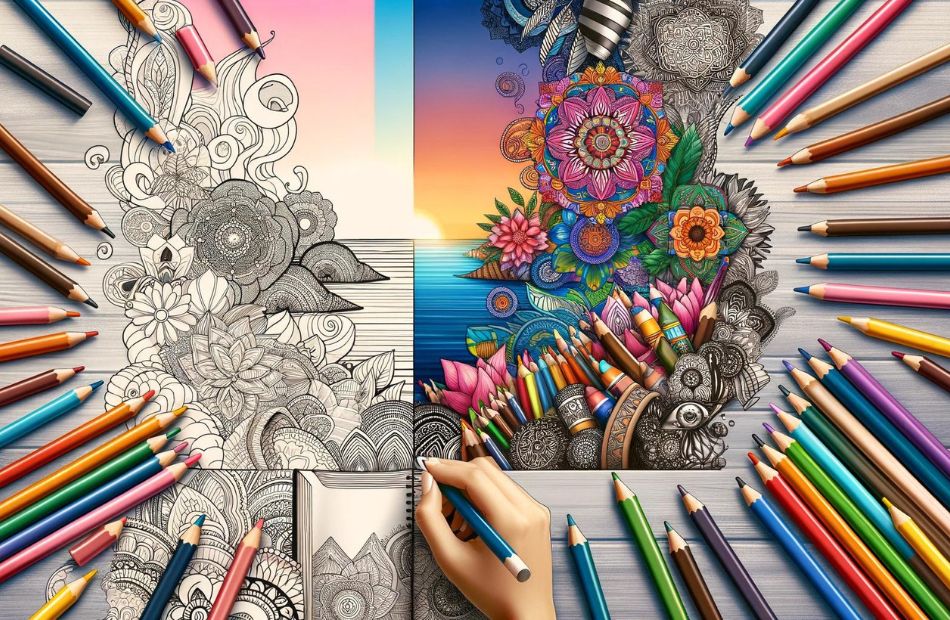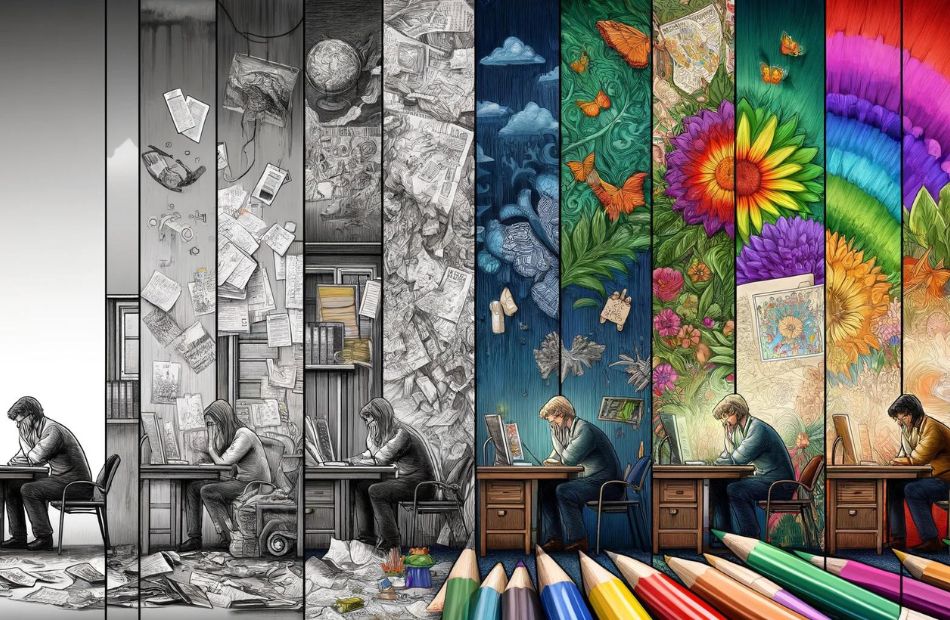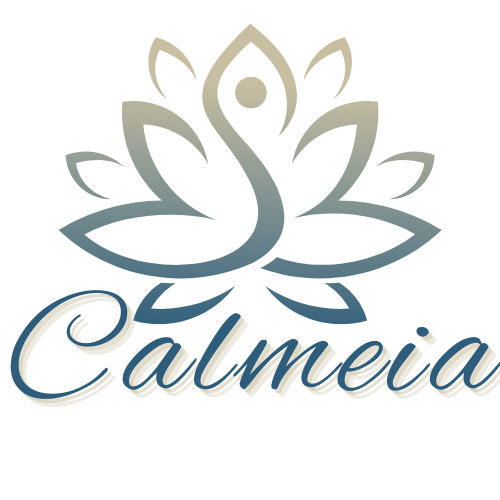Stress Relief? Hey there! Let’s talk about something we’re all too familiar with—stress. You know, that feeling when you’re juggling a million things, and your brain feels like it’s about to short-circuit? Yep, that’s the one. We all deal with it, from work deadlines to the endless scroll of social media. It’s like a shadow that follows us around, affecting our mood, health, and overall vibe.
Now, what if I told you there’s a surprisingly simple, yet incredibly effective way to kick stress to the curb? Enter the world of coloring. Yes, you heard me right—coloring, like what we did as kids, but this time, it’s not just for the little ones. Adult coloring books have taken the world by storm, becoming the go-to stress buster for grown-ups seeking a break from the chaos of everyday life.
Picture this: intricate designs, from serene landscapes to mesmerizing mandalas, waiting to come alive with a splash of color. It’s not just an activity; it’s an escape, a moment of zen in the hustle and bustle of modern life. And the best part? You don’t need to be Van Gogh or have a stash of fancy art supplies. All you need is a coloring book that speaks to you and some pencils or markers, and you’re all set to turn that stress dial way down.
So, how did coloring books make their grand entrance into the adult world? It started as a whisper, a niche hobby among those in the know, and then exploded into a full-blown trend. Suddenly, bookstores and online platforms were flooded with options, each offering a unique gateway to tranquility. And as for the artists behind these books, they’ve become rock stars in their own right, crafting worlds for us to get lost in, one page at a time.
In the chapters that follow, we’ll dive deeper into the why and the how—why coloring works wonders for stress relief and how you can get the most out of this colorful journey. From the science of stress to the stories of those who’ve found solace in their coloring books, we’re about to embark on a vibrant exploration of color, creativity, and calm. So grab your favorite colored pencils, and let’s get started on this colorful adventure together!
The Rise of Adult Coloring: From Childhood Nostalgia to Modern Mindfulness

Remember those days when the biggest decision was choosing between the cerulean blue and the aquamarine crayon to color the sky in your coloring book? Fast forward to the present, and guess what? Coloring books are back with a vengeance, but this time, they’re not just for the kiddos. Adult coloring books have erupted onto the scene, transforming from a quaint pastime into a global phenomenon that’s all about mindfulness, relaxation, and, yes, a touch of nostalgia.
So, how did we go from reminiscing about our childhood coloring escapades to embracing coloring as a legitimate stress-relief tool for adults? It’s a colorful tale, to say the least. A few years back, someone had the brilliant idea to create coloring books specifically designed for adults, featuring intricate patterns and themes far beyond the simplistic outlines of our youth. These weren’t your average fairy tale scenes; they were elaborate mandalas, detailed animal patterns, and breathtaking landscapes—all waiting for a splash of color.
The idea caught on like wildfire. Suddenly, adult coloring books were everywhere: in bookstores, on bestseller lists, and all over social media. People began sharing their meticulously colored pages online, boasting vibrant designs that showcased not just creativity but a deep sense of personal accomplishment. The trend spoke to something deep within us—a longing for a simpler time, perhaps, or the need for a creative outlet that didn’t require a screen.
But who are the Picassos behind these black-and-white masterpieces? Artists around the globe have stepped into the spotlight, turning their passion for design into intricate coloring books. These aren’t just books; they’re collections of art, carefully crafted to guide us on a journey of color and calm. The artists behind them have become heroes of sorts, leading the charge in the battle against stress and anxiety, one coloring page at a time.
And it’s not just about the nostalgia or the joy of creating something beautiful. There’s a science to it, a method behind the magic. Coloring taps into a part of our brain that craves focus and simplicity, offering a break from the overstimulation of our digital lives. It’s a meditative act, a way to slow down and be present in the moment—qualities often lost in the hustle and bustle of modern life.
So, as we turn the page on this chapter of the coloring book craze, it’s clear that what started as a childhood pastime has blossomed into a meaningful mindfulness practice. Adult coloring books are more than just a fad; they’re a testament to the power of creativity, the importance of self-care, and the enduring appeal of a life colored with joy and peace. Let’s keep turning those pages and see where this vibrant journey takes us.
The Psychology Behind Coloring: Unraveling the Rainbow Connection to Our Minds

Ever wondered why filling in those intricate designs with your favorite hues feels so darn good? It turns out, there’s a whole rainbow of reasons why coloring can be your brain’s best friend, especially when it comes to melting away stress. Let’s dip our brushes into the psychological palette and discover what makes coloring not just fun, but fundamentally soothing for our minds.
First off, coloring is like giving your brain a gentle nudge into the present moment, saying, “Hey, let’s focus on this beautiful pattern right now.” This act of focusing on a simple, engaging task helps push pause on the endless chatter and worries crowding our minds. It’s a form of mindfulness, or meditation in motion, if you will. Instead of sitting quietly with your thoughts (which, let’s be honest, can be a bit much sometimes), coloring offers an active way to achieve a meditative state. Your mind gets to take a breather, focusing solely on the colors and shapes before you.
Now, let’s talk about the psychological effects of engaging with color and patterns. Colors, with their myriad of hues and shades, have the power to influence our mood and emotions. Ever felt calmer looking at a soothing shade of blue or energized by a vibrant red? That’s color psychology at play. When you choose colors for your coloring book, you’re not just making art; you’re crafting your own emotional landscape, painting your mood with every stroke.
Research has started to back up what many have felt intuitively: coloring can lead to reduced stress and anxiety levels. Studies have found that participants who engaged in coloring sessions reported lower levels of anxiety and improved mindfulness. The repetitive motion, the focus on detail, and the creative expression involved in coloring all contribute to this calming effect. It’s like each stroke of color is a step away from stress and a step toward inner peace.
But here’s where it gets even more interesting. Coloring can activate different areas of our brain, including those involved in creativity and sensory processing. It’s a workout for your brain, but the fun kind, where you end up with a beautiful piece of art. This brain engagement can lead to improved focus, problem-solving skills, and even enhance your ability to enter a flow state, where time seems to fly by as you’re fully immersed in what you’re doing.
In essence, the psychology behind coloring is as colorful as the activity itself. It’s a blend of mindfulness, emotional expression, and cognitive engagement—a trifecta of mental wellness benefits wrapped up in one seemingly simple activity. So next time you pick up those coloring pencils and dive into your coloring book, remember, you’re not just passing time; you’re giving your mind a much-needed retreat, painting your way to peace and clarity. Let the colors lead the way!
Coloring Techniques for Maximum Benefit: Crafting Your Calm

Alright, let’s get our hands a little colorful and dive into how you can elevate your coloring experience from just a casual pastime to a full-on zen session. You might be thinking, “Do I really need techniques to color?” Not necessarily, but if you’re aiming to maximize those stress-relief benefits, a few tips and tricks can transform your coloring time into a more meditative and rewarding practice. So, sharpen those pencils, and let’s explore how to craft your calm through coloring.
Choosing Your Tools Wisely
The first step on this journey is picking the right materials. Not all coloring books and tools are created equal, and what you choose can significantly affect your experience. If you’re just starting, look for a coloring book that resonates with you. Whether it’s intricate mandalas, serene landscapes, or whimsical animals, your subject matter should invite you in, making you eager to add color to the page.
When it comes to coloring tools, it’s a personal choice between pencils, markers, or even watercolors. Colored pencils offer precision and a wide range of shading techniques, making them perfect for detailed designs. Markers, on the other hand, provide vibrant colors and a different kind of flow but can bleed through pages if you’re not careful. Watercolors add a lovely, soft touch to your designs but require thicker paper to handle the moisture. Experiment with different mediums to find what feels most natural and soothing for you.
Setting the Scene
Creating a calming environment for coloring can significantly enhance the stress-relief benefits. Find a quiet, comfortable spot where you won’t be interrupted. Maybe play some soft music or nature sounds in the background to help you relax further. The key is to make your coloring time a sacred ritual, a moment you dedicate entirely to yourself and your well-being.
Techniques to Try
- Start Simple: Begin with easier designs and gradually work your way up to more complex patterns. This approach helps build confidence and reduces any initial frustration.
- Color Coordination: Before diving in, select a color palette that appeals to you. Coordinating colors can be a meditative process in itself, allowing you to think about balance and harmony on the page.
- Mindful Coloring: As you color, focus on the process rather than the outcome. Notice the feel of the pencil in your hand, the texture of the paper, and the way the colors blend. This mindfulness aspect is key to turning coloring into a stress-relieving practice.
- Breathing Techniques: Combine your coloring with deep, slow breaths to enhance relaxation. Inhale deeply as you draw a line, and exhale as you finish it. This rhythmic breathing can help center your mind and reduce anxiety.
Remember, there’s no right or wrong way to color. The goal is to enjoy the process, let go of stress, and express yourself creatively. By choosing the right tools, setting the scene, and applying a few mindful techniques, you can transform coloring into a powerful practice for finding peace and calm in your daily life. So, grab those colors and let the journey to relaxation begin!
Coloring Beyond the Book: Expanding the Canvas of Stress Relief

As we’ve journeyed through the world of coloring for stress relief, we’ve seen how personal narratives and scientific insights weave together to highlight its profound impact. But what if I told you the story doesn’t end with the last page of your coloring book? In fact, the canvas of creativity and stress management extends far beyond, into innovative realms and communal spaces that further enrich this colorful practice. Let’s explore how coloring has transcended traditional boundaries, inviting us into even more vibrant and connected experiences.
Digital Coloring: A New Frontier
Welcome to the digital age, where coloring meets technology, offering a new dimension of convenience and creativity. Digital coloring apps have emerged, transforming tablets and smartphones into canvases waiting for your touch. These apps not only replicate the coloring book experience but also offer infinite palettes and undo buttons—forgiving features that traditional paper cannot. For those constantly on the move or looking to minimize physical clutter, digital coloring provides a portable and eco-friendly alternative, proving that stress relief can be as accessible as your device.
Coloring Clubs: Creating Communities
Imagine walking into a room filled with tables adorned with coloring books and an array of colorful pens and pencils, where the only agenda is to relax and connect. Coloring clubs, popping up in libraries, community centers, and cafes, are bringing people together over shared coloring experiences. These gatherings break down social barriers, offering a space for conversation, laughter, and mutual support. In these clubs, coloring becomes more than a solitary activity; it’s a communal ritual that fosters belonging and reduces isolation, demonstrating that sometimes, the best stress relief comes from being part of a colorful community.
Public Art Projects: Coloring the World
Now, picture a public square transformed into a giant coloring page, inviting passersby to leave their mark with colors. Around the world, public art projects are incorporating coloring elements, turning urban landscapes into interactive art installations. These projects not only beautify public spaces but also invite communal participation, turning everyday environments into opportunities for creativity and relaxation. By stepping out of the book and into the world, coloring becomes a dynamic act of co-creation, reinforcing the idea that art, in its most inclusive form, can be a powerful tool for collective well-being.
Social Media: Sharing the Spectrum
In the digital realm, social media platforms have become galleries for sharing colored creations. Hashtags like #AdultColoring bring together a global community of coloring enthusiasts, where each post is a window into someone’s moment of zen. These online spaces provide inspiration, celebrate progress, and offer tips and encouragement, reinforcing the idea that our individual efforts are part of a larger tapestry of creativity and calm. Through likes, shares, and comments, the solitary act of coloring transforms into a shared journey, highlighting the connective power of art and technology.
As we look beyond the traditional coloring book, it’s clear that the essence of coloring—its ability to soothe, inspire, and connect—transcends pages and permeates our digital and physical worlds. Whether through an app, a club, a public art project, or a social media post, the opportunities to engage with coloring as a form of stress relief are as boundless as our imagination. In expanding the canvas of coloring, we’re invited to explore new horizons of creativity and community, painting our path to peace with every hue of the human experience.
Criticisms and Controversies: Addressing the Coloring Book Debate

As we’ve colored outside the lines of conventional stress relief methods, embracing the serene world of coloring, it’s essential to acknowledge the palette isn’t without its shades of skepticism. Amid the praises and shared experiences of tranquility, criticisms of adult coloring books as a form of stress relief have emerged, sparking a debate worth exploring. So, let’s gently dip our brushes into this less colorful pool of concerns to understand the nuances and address the controversies surrounding adult coloring.
A Distraction Rather Than a Solution
One of the primary critiques leveled against adult coloring books is that they serve more as a distraction than a genuine solution to stress or mental health issues. Critics argue that while coloring can offer temporary relief, it might encourage avoidance behaviors, leading individuals to color away their problems instead of confronting and resolving them. This perspective suggests that while coloring might quiet the mind momentarily, it doesn’t equip individuals with the skills needed to manage stress or anxiety in the long run.
The Limitations of Coloring as Therapy
While many tout coloring as a therapeutic activity, some psychologists and therapists caution against conflating it with professional therapy. They point out that while coloring can be a useful tool in a broader therapeutic context, it shouldn’t be seen as a substitute for professional help when dealing with serious mental health issues. The concern is that the therapeutic label might be misleading, potentially deterring individuals from seeking the specialized support they may need.
The Commercialization of Mindfulness
As adult coloring books surged in popularity, so did concerns about the commercialization of mindfulness and meditation practices. Critics argue that the trend commodifies centuries-old practices, packaging them into a consumer product that simplifies and sells the concept of mindfulness as something that can be achieved through a single activity. This commercial aspect raises questions about the authenticity and depth of the mindfulness experience offered through coloring.
Addressing the Criticisms
In response to these criticisms, proponents of coloring for stress relief argue that its value lies in its accessibility and simplicity. While not a panacea for all mental health challenges, coloring is seen as an entry point, a way to introduce mindfulness and meditation to those who might find traditional methods intimidating or inaccessible. It’s presented as one tool among many in the stress-relief toolbox, valuable for its ability to offer immediate, tangible relief in moments of anxiety or overwhelm.
Furthermore, the social aspect of coloring, particularly through coloring clubs and online communities, counters the notion of it being merely a solitary, avoidant activity. These communal experiences highlight the potential for coloring to facilitate connection and conversation, providing a supportive space for sharing and healing.
As for the commercialization concerns, while it’s true that the mindfulness trend has been embraced by the market, this accessibility has also played a crucial role in bringing awareness and acceptance to mental health care. The widespread availability of coloring books and resources has democratized the practice, making it easier for people to find an outlet that suits them.
In the end, the coloring book debate underscores the importance of balance and perspective. Coloring is a tool, not a cure-all. It’s a complementary practice that, when used alongside other methods of stress management and mental health care, can contribute to overall well-being. As we continue to navigate the complexities of stress and self-care, perhaps the most important lesson is to keep an open mind about the myriad ways people find peace, understanding, and joy in the strokes of their day-to-day lives.
Conclusion: Embracing the Spectrum of Stress Relief Through Coloring
As we reach the end of our colorful exploration into the world of adult coloring as a form of stress relief, it’s clear that this activity, like any good art piece, is layered with complexity and nuance. From its humble beginnings to becoming a global phenomenon, coloring has invited adults back to a simpler time while offering a gentle yet powerful tool for managing the stress of modern life. It’s a testament to the idea that sometimes, the most profound forms of relaxation and mindfulness come wrapped in the simplest of packages.
Coloring stands as a beacon of accessibility in the vast sea of stress relief methods, proving that you don’t need expensive equipment or extensive training to find a moment of peace. This activity, embraced by millions, showcases the universal need for and benefit of taking a step back from our hectic lives to focus on creating beauty from chaos, one page at a time.
However, as we’ve seen, coloring is not without its critics. It’s important to recognize that while coloring can be an immensely beneficial tool for stress relief, it’s part of a broader palette of wellness practices. It serves as a complement, not a replacement, for other forms of therapy and self-care. Addressing the complexities of mental health requires a multifaceted approach, and coloring is just one hue in the spectrum of options available.
The controversies and debates surrounding adult coloring highlight the evolving conversation about mental health, self-care, and the ways in which we seek solace and clarity in a turbulent world. They remind us of the importance of maintaining a balanced view of wellness practices, encouraging a holistic approach to mental health that honors individual needs and preferences.
Looking forward, the future of coloring as a stress relief method seems as bright and promising as the pages of a freshly opened coloring book. With the rise of digital platforms, community events, and innovative applications of coloring in therapeutic settings, this simple activity continues to evolve, offering new ways to connect, reflect, and find peace.
In conclusion, whether you’re a seasoned colorist or someone contemplating picking up a coloring book for the first time, the journey of coloring for stress relief is one of personal discovery and expression. It’s a reminder that in the midst of life’s complexities, there’s profound power in picking up a pencil and coloring outside the lines, finding your own path to peace and mindfulness. So, as we close this chapter, let’s keep turning the pages, coloring our way to a calmer, more colorful existence.
If you’re looking to create a soothing, stress-relief atmosphere, immerse yourself in the tranquil sounds of Amazing Sound Escapes on YouTube, where serenity awaits in every note.
For a peaceful escape into creativity and calm, discover our Mandala Coloring Book for Stress Relief, where each page invites you to unwind and express your inner tranquility.



